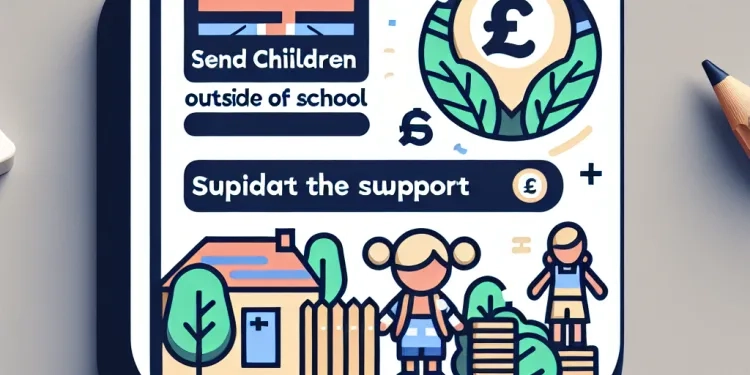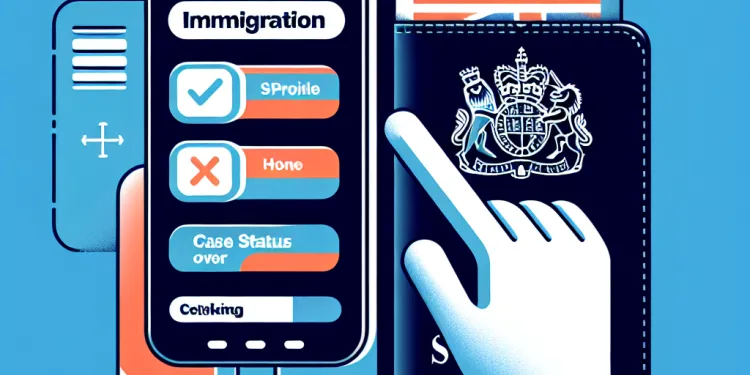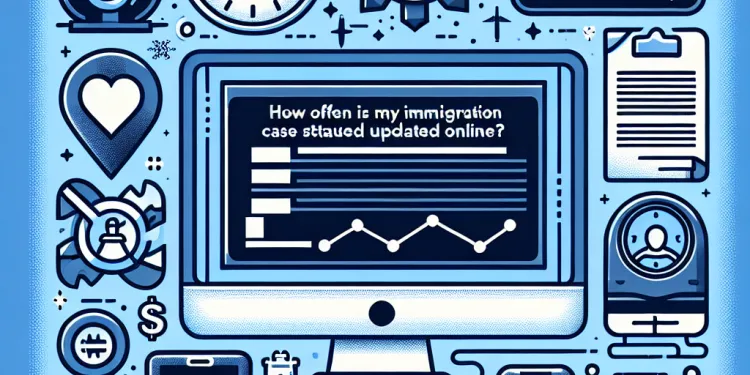
Find Help
More Items From Ergsy search
-

Can SEND status change over time?
Relevance: 100%
-

What are SEND children?
Relevance: 64%
-

Who are SEND children?
Relevance: 58%
-

What does SEND stand for?
Relevance: 56%
-

Can I send money to an inmate?
Relevance: 55%
-

Do SEND children attend mainstream schools?
Relevance: 53%
-

Are there specific laws governing SEND in schools?
Relevance: 53%
-

Who is responsible for assessing SEND needs?
Relevance: 53%
-

Where can I check the status of my application?
Relevance: 52%
-

How is progress measured for SEND children?
Relevance: 52%
-

What are some common misconceptions about SEND?
Relevance: 52%
-

How are parents involved in the SEND process?
Relevance: 52%
-

How can I check my immigration status online?
Relevance: 52%
-

How do I send books or magazines?
Relevance: 52%
-

How do funding and resources affect SEND support?
Relevance: 52%
-

What support is available for SEND children in schools?
Relevance: 51%
-

Can SEND children access extracurricular activities?
Relevance: 51%
-

Can I get updates on my immigration status via email?
Relevance: 51%
-

What are some common types of SEND?
Relevance: 50%
-

How can I get information on my immigrations status?
Relevance: 50%
-

Why does my email appear to be sending spam?
Relevance: 50%
-

What items can I send to someone in prison?
Relevance: 50%
-

What support is available outside of school for SEND children?
Relevance: 50%
-

Is documentation of student status required for the payment?
Relevance: 49%
-

What role do teachers play in supporting SEND children?
Relevance: 49%
-

How can schools create an inclusive environment for SEND children?
Relevance: 48%
-

What is the USCIS Case Status Online tool?
Relevance: 48%
-

Can I check the status of my immigration case by phone?
Relevance: 47%
-

How often is my immigration case status updated online?
Relevance: 46%
-

What information do I need to check my immigration status online?
Relevance: 46%
-

What should I do if my case status has not changed in a long time?
Relevance: 43%
-

My friend has received their status update, and I haven't. Should I be worried?
Relevance: 43%
-

Can I visit a USCIS office to inquire about my immigration status?
Relevance: 42%
-

Why does my online case status show 'case received' for a long time?
Relevance: 40%
-

Can my attorney check my immigration status for me?
Relevance: 39%
-

How can I identify if my child has SEND?
Relevance: 37%
-

How can parents advocate for their SEND child?
Relevance: 37%
-

Will my council send a refund check if I overpay?
Relevance: 36%
-

Can inmates send mail?
Relevance: 28%
-

Is it legal to watch live TV without a license if I send it from a non-UK server?
Relevance: 27%
Understanding SEND Status
Special Educational Needs and Disabilities (SEND) status is a designation in the UK educational system used to identify children and young people who require additional support to meet their educational potential. This covers a wide range of needs, from physical disabilities to learning difficulties, emotional and behavioural issues, and communicative or social impairments. SEND support is provided through a graduated approach, ranging from school-based interventions to more extensive support through an Education, Health and Care Plan (EHCP).
Can SEND Status Change?
SEND status is not necessarily permanent and can change over time. The aim of SEND support is to help learners achieve their best possible educational outcome. As such, the level and type of support required can vary based on the individual’s development and circumstances. Children and young people can progress or face new challenges, thus necessitating a review and potential adjustment of their SEND status.
Factors Influencing Change in SEND Status
Several factors can influence changes in a child's SEND status. Developmental progress is one such factor; as a child grows, their needs may lessen with effective support and intervention. Conversely, new or more significant challenges could arise, demanding enhanced support. Environmental changes, such as transitioning from primary to secondary school or changes at home, can also impact a learner's needs and consequently, their SEND status.
The Role of Regular Reviews
Regular assessments and reviews are crucial in evaluating SEND status. These reviews involve a collaborative process with educators, parents, and specialists who monitor the child’s development and adjust strategies as required. This ensures that any progress is recognized, and any emerging needs are promptly addressed. Reviews typically occur annually if an EHCP is in place, although more frequent evaluations may be conducted if necessary.
Outcomes of Changed SEND Status
A change in SEND status can have several outcomes. For some, it might mean a reduction in the level of additional support as they achieve greater independence in their learning. For others, it could involve more focused or different types of interventions as new needs are identified. It is critical that these changes are approached with sensitivity and are thoroughly discussed with all stakeholders, including the child and their family.
Conclusion
In conclusion, SEND status can indeed change over time, reflecting the dynamic nature of a child’s educational journey. The ability to adapt support to meet evolving needs is a hallmark of an effective SEND framework. As the needs of students can be complex and multifaceted, a flexible and responsive approach ensures that every child receives the appropriate support to thrive academically and socially. This commitment to monitoring and adjusting support plans underscores the UK’s dedication to inclusive education for all students.
Understanding SEND Status
SEND stands for Special Educational Needs and Disabilities. It is a way to identify children in the UK who need extra help at school. This could be because of a physical disability, learning difficulty, or problems with emotions, behavior, talking, or making friends. SEND support can be small changes in school or bigger help through a plan called an Education, Health and Care Plan (EHCP).
Can SEND Status Change?
SEND status can change. It is not always the same forever. The goal of SEND support is to help children do their best at school. This means the help they need can change as they grow and their situations change. Kids might improve or face new problems, and then their SEND status might be updated.
Factors Influencing Change in SEND Status
Several things can change a child's SEND status. As a child grows, they might need less help if they get good support. But if new problems come up, they might need more help. Changes at school or home, like moving to a new school or changes in the family, can also affect their needs and SEND status.
The Role of Regular Reviews
Regular check-ups are important for looking at SEND status. These check-ups involve teachers, parents, and specialists working together. They watch how the child is doing and change plans if needed. This way, how the child is doing is noticed, and any new needs are quickly addressed. They usually do these check-ups once a year if there is an EHCP, but they can happen more often if needed.
Outcomes of Changed SEND Status
If SEND status changes, different things can happen. Some children might need less help as they learn to do more on their own. Others might need different help as new needs are found. It is important to talk about these changes carefully with everyone involved, including the child and their family.
Conclusion
In summary, SEND status can change over time. This is because children grow and their needs can change. The best SEND support is able to change as needed. This helps every child get the right help to do well at school and with friends. The UK cares about making sure all students get the support they need to succeed.
Frequently Asked Questions
Can SEND status change over time?
Yes, SEND status can change over time as a child's needs evolve and assessments occur.
What factors can influence a change in SEND status?
Factors such as new assessments, interventions, developmental progress, or changing circumstances can influence a change in SEND status.
Is it common for SEND status to change?
It is not uncommon for SEND status to change as children grow and their educational needs are reassessed.
Who decides if a child's SEND status should change?
Decisions about changing SEND status are typically made by educational professionals in consultation with parents and specialists.
Do all children with SEND have permanent needs?
Not all children with SEND have permanent needs; some may outgrow certain difficulties or benefit significantly from support.
What kind of assessments can lead to a change in SEND status?
Psychological assessments, educational evaluations, medical diagnoses, and multi-disciplinary reviews can all lead to changes in SEND status.
Can interventions affect SEND status?
Effective interventions can sometimes reduce or resolve certain needs, potentially changing SEND status.
How often is SEND status reviewed?
SEND status is usually reviewed at least annually, but more frequent reviews can be requested if necessary.
Is a formal process required to change SEND status?
Yes, changes to SEND status typically involve a formal process with assessments and documentation.
Can parents request a review of their child’s SEND status?
Yes, parents can request a review of their child’s SEND status if they believe their child's needs have changed.
What role do schools play in changing SEND status?
Schools play a crucial role in identifying changing needs and collaborating on decisions regarding SEND status.
Can a child's SEND status change when they transition to a new school?
Transitioning to a new school can prompt a reassessment and potential changes in SEND status.
Does a change in SEND status affect the support a child receives?
Yes, a change in SEND status can affect the type and level of support a child receives.
Are there government guidelines on changing SEND status?
Yes, most countries have guidelines and policies regarding the assessment and review process for SEND status.
Can health improvements lead to a change in SEND status?
Improvements in health conditions can reduce certain needs and lead to changes in SEND status.
What is an example of a temporary SEND need?
A temporary SEND need might be support for a speech delay that resolves over time with intervention.
How does puberty affect SEND status?
Puberty can bring developmental changes that may impact SEND needs and status, either increasing or decreasing support requirements.
Can socio-emotional development impact SEND status?
Changes in socio-emotional development can impact SEND status, especially if new needs or strengths emerge.
Is it possible for a child to no longer need SEND support?
Yes, with appropriate intervention and development, some children may no longer need SEND support.
Do all changes in SEND status result from improvement?
No, changes can occur due to new challenges or conditions, not just improvement or resolution of needs.
Can SEND Status Change Over Time?
SEND stands for Special Educational Needs and Disabilities.
Yes, SEND status can change. A child might need extra help at one time but not forever. Sometimes, with support, they might improve and need less help. Other times, they might need more support as they grow.
It's important for parents and teachers to talk and share information. They can use reports and checklists to see how the child is doing.
Supportive tools like reading helpers or speech therapy can help children with SEND. Regular check-ins are good to see if the child needs more or less help.
Yes, SEND status can change. This happens when a child's needs change and when people check what help they need.
What can cause a change in SEND status?
Sometimes things can change for a child with special educational needs and disabilities (SEND). This can happen because of new tests, new help being given, the child growing and learning, or because things in their life change.
Do SEND needs change often?
SEND means Special Educational Needs and Disability. Sometimes, a child's needs can change. It is okay for SEND needs to change. It can happen when a child grows or learns new things.
If you want to know more, ask a teacher or a helper at school. They can use pictures or simple words to help you understand better.
Sometimes, the help a child needs at school can change as they grow up and as teachers learn more about what they need.
Who decides if changes are made to a child's SEND support?
Decisions about changing SEND status are usually made by teachers, parents, and experts working together.
Do all children with SEND always have special needs?
No, not all children with SEND have special needs all the time.
Some children might need extra help only for a while. Others might need help for a long time.
If you know someone with SEND, tools like pictures, apps, or talking with a teacher can help them learn better.
Not all kids with SEND have needs that last forever. Some kids might get past their problems, or they might do a lot better with help.
What tests can change SEND status?
SEND means Special Educational Needs and Disabilities. Sometimes, someone with SEND might need different help. Different tests can tell us if things need to change. These tests check how someone learns or feels. They make sure the person gets the right support.
Here are some examples:
- Learning Tests: These tests see how a person reads, writes, or does maths.
- Speech and Language Tests: These tests look at how a person talks and understands words.
- Behavior Tests: These tests find out how a person behaves at school or home.
- Health Check: This checks if health problems affect learning.
These tests can help teachers and parents know the best ways to help someone with SEND. Using pictures or videos can also help in understanding these tests better.
Sometimes, we do tests or checks to see how someone is doing. These checks can be about how we think, learn, or our health. Different experts might help. These checks can change if a child needs extra help at school.
Can help change SEND status?
SEND means Special Educational Needs and Disabilities. It means some kids need extra help at school.
Interventions are special ways to help children learn better. They are like extra lessons or activities.
This question asks if these special helps can change a child's SEND status. It wants to know if they could help the child need less extra help.
To find the answer, teachers and parents can work together. They can try different ways to help the child.
Using tools like picture cards or simple apps can also be good. These can make learning easier and more fun.
Good help can sometimes make things better. It might even change if someone needs special support at school.
How often do we check SEND status?
The SEND status is checked once a year. But if needed, you can ask for it to be checked more often.
Do you need a special process to change SEND status?
Yes, changing SEND status usually needs a formal process with tests and paperwork.
Can parents ask for a check of their child's SEND status?
Parents can ask the school to look at their child's SEND (Special Educational Needs and Disabilities) status again. This is called a review. You might do this if you think your child needs more or different help.
Tips:
- Talk to your child's teacher regularly.
- Write down any concerns you have.
- Ask for a meeting with the school to discuss your child's needs.
Yes, parents can ask to check their child’s special needs status if they think their child’s needs have changed.
How do schools help change SEND status?
Schools can help with SEND (special educational needs and disabilities) changes. They work with parents and teachers to see what a child needs.
Here are some things schools do:
- Look at how the child learns and plays.
- Talk to the child’s family and teachers.
- Make a plan to help the child learn better.
- Check if the child needs extra support.
Tools to help:
- Use pictures or simple charts.
- Provide quiet spaces for learning.
- Let children use computers or tablets.
Schools have an important job. They help find out when kids need extra help and work with others to make decisions about it.
Can a child's extra help needs change when they move to a new school?
Children might need different help when they go to a new school. This is because new places have different things and people. Sometimes, a child might get more help, or they might need less help.
It's a good idea to talk to the new school about any help your child needs. You can also use pictures, simple words, or stories to explain things to your child. This can make it easier for them to understand and feel okay about the change.
Starting a new school might mean looking at your SEND (Special Educational Needs and Disabilities) status again. This could lead to some changes.
Does changing SEND status change the help a child gets?
If a child's SEND status changes, the help they get at school might also change.
Here is what might happen:
- If the child needs more help, they might get extra support.
- If the child needs less help, some support might change or stop.
It is important to talk with the teachers or school helpers to understand what will happen and make sure the child gets the right support.
Tools that can help:
- Talking with teachers often.
- Using pictures or drawings to understand changes.
- Keeping a notebook to write down important information.
Yes, when the Special Educational Needs and Disabilities (SEND) status changes, it can change the kind of help and support a child gets.
Does the government have rules for changing SEND status?
Yes, most countries have rules about checking and helping kids with SEND (Special Educational Needs and Disabilities).
Can getting healthier change SEND status?
When health gets better, it can change what help someone needs. This might mean their SEND status changes too. SEND is for Special Educational Needs and Disabilities.
Helpful tools like pictures or simple charts can make understanding easier. Talking with teachers or using apps that read text aloud can also help.
What is a temporary SEND need?
A temporary SEND need is when a child needs extra help for a short time.
For example, if a child breaks their hand, they might need help in class until it gets better.
Using a laptop to type can help while the hand heals.
A temporary SEND need means help is needed for a short time. For example, a child might need help with talking clearly. With special help, they might learn to talk clearly on their own over time.
How does growing up change SEND needs?
Growing up means your body and feelings change. This time is called puberty. Some children have special needs at school, called SEND. When they grow up, their needs might change too.
When you understand these changes, it can help. Using pictures or simple stories can make it easier to learn about growing up.
It's important to talk with teachers or helpers if you feel different. They can help you with any worries.
When kids grow into teenagers, their bodies and feelings change. This time is called puberty. These changes might mean they need more help, or sometimes less help, at school.
Can feelings and emotions affect special needs?
Does the way we feel and how we share feelings change if someone has special learning needs?
Some tools to help understand this are:
- Using picture books
- Talking with a teacher
- Using feelings charts
Changes in how we feel and get along with others can affect if someone needs extra help at school. This is because they might need more support or show new talents.
Can a child stop needing extra help at school?
Sometimes, children need extra help at school. This is called SEND support.
As time goes on, some children may not need this extra help anymore.
Teachers and parents can use helpful tools to see how a child is doing. These can include:
- Regular meetings to talk about progress
- Charts to track learning
- Games and activities to help learn
With support, a child might learn well and need less help later.
Yes, with the right help and support, some children might not need extra support as they grow.
Do all SEND status changes mean things got better?
No, things can change because of new problems or situations, not just because things get better or needs are met.
Useful Links
- Ergsy carfully checks the information in the videos we provide here.
- Videos shown by Youtube after a video has completed, have NOT been reviewed by ERGSY.
- To view, click the arrow in centre of video.
- Most of the videos you find here will have subtitles and/or closed captions available.
- You may need to turn these on, and choose your preferred language.
- Go to the video you'd like to watch.
- If closed captions (CC) are available, settings will be visible on the bottom right of the video player.
- To turn on Captions, click settings .
- To turn off Captions, click settings again.
More Items From Ergsy search
-

Can SEND status change over time?
Relevance: 100%
-

What are SEND children?
Relevance: 64%
-

Who are SEND children?
Relevance: 58%
-

What does SEND stand for?
Relevance: 56%
-

Can I send money to an inmate?
Relevance: 55%
-

Do SEND children attend mainstream schools?
Relevance: 53%
-

Are there specific laws governing SEND in schools?
Relevance: 53%
-

Who is responsible for assessing SEND needs?
Relevance: 53%
-

Where can I check the status of my application?
Relevance: 52%
-

How is progress measured for SEND children?
Relevance: 52%
-

What are some common misconceptions about SEND?
Relevance: 52%
-

How are parents involved in the SEND process?
Relevance: 52%
-

How can I check my immigration status online?
Relevance: 52%
-

How do I send books or magazines?
Relevance: 52%
-

How do funding and resources affect SEND support?
Relevance: 52%
-

What support is available for SEND children in schools?
Relevance: 51%
-

Can SEND children access extracurricular activities?
Relevance: 51%
-

Can I get updates on my immigration status via email?
Relevance: 51%
-

What are some common types of SEND?
Relevance: 50%
-

How can I get information on my immigrations status?
Relevance: 50%
-

Why does my email appear to be sending spam?
Relevance: 50%
-

What items can I send to someone in prison?
Relevance: 50%
-

What support is available outside of school for SEND children?
Relevance: 50%
-

Is documentation of student status required for the payment?
Relevance: 49%
-

What role do teachers play in supporting SEND children?
Relevance: 49%
-

How can schools create an inclusive environment for SEND children?
Relevance: 48%
-

What is the USCIS Case Status Online tool?
Relevance: 48%
-

Can I check the status of my immigration case by phone?
Relevance: 47%
-

How often is my immigration case status updated online?
Relevance: 46%
-

What information do I need to check my immigration status online?
Relevance: 46%
-

What should I do if my case status has not changed in a long time?
Relevance: 43%
-

My friend has received their status update, and I haven't. Should I be worried?
Relevance: 43%
-

Can I visit a USCIS office to inquire about my immigration status?
Relevance: 42%
-

Why does my online case status show 'case received' for a long time?
Relevance: 40%
-

Can my attorney check my immigration status for me?
Relevance: 39%
-

How can I identify if my child has SEND?
Relevance: 37%
-

How can parents advocate for their SEND child?
Relevance: 37%
-

Will my council send a refund check if I overpay?
Relevance: 36%
-

Can inmates send mail?
Relevance: 28%
-

Is it legal to watch live TV without a license if I send it from a non-UK server?
Relevance: 27%